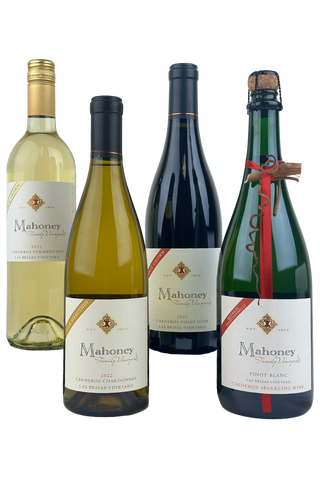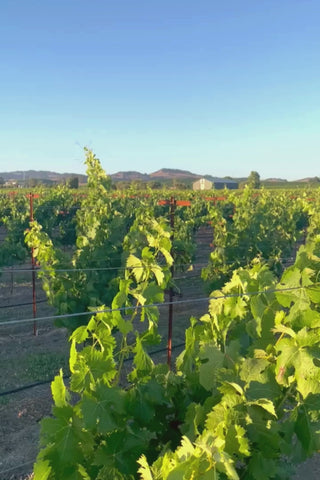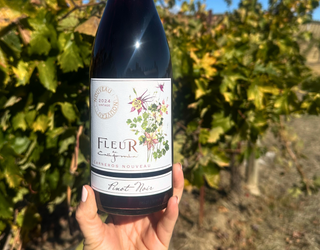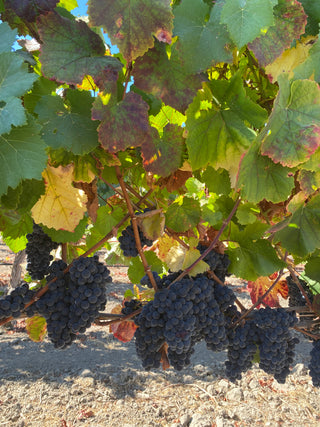
Nestled in the picturesque Carneros region of California, Las Brisas Vineyard stands as a testament to the beauty and elegance of winemaking in one of the most renowned wine-producing areas in the world. Located at the bottom southern points where Napa and Sonoma counties meet, it greatly benefits from its proximity to the San Pablo Bay and Petaluma Gap. The fog and winds that make their way through to Los Carneros create ideal conditions for growing chardonnay and pinot noir, and Las Brisas Vineyard is no exception. This cool climate, coupled with well-draining sandy soil (less clay than would be typical), creates optimal conditions for cultivating grapes with vibrant acidity and complex flavors.
A Glimpse into History:
The Schellville area (Sonoma) of Carneros was a strong dairy and farming community prior to the boom of the wine industry during the 1960s and 1970s. Cool climate varieties were king at the time, and the initial growers in the area knew pinot noir would be the best option for the climate and soil. Land was also cheaper in Carneros compared to that of Napa Valley, and pinot made better sense to plant, compared to Cabernet, where the wineries could charge a lot more per bottle. Cool-climate, Burgundian style wines and sparkling wines were becoming very popular, and pinot noir and chardonnay are the two main grapes in sparkling wines (pinot meunier is also used, but those varietals, like pinot gris and pinot blanc, are variations of pinot noir).
Francis founded Carneros Creek Winery in 1972 (the first winery to be built in Carneros since the turn of the century). His interest in the wine business came after travelling through Europe and then becoming an importer of European wines. He first purchased a piece of land on the Napa side of Carneros, and knew pinot noir was going to be his main focus. The climate and soil of Carneros carried much potential for pinot, and Francis realized that clones were going to be the next most important step in creating a truly perfect Carneros pinot. He worked with UC Davis on the Carneros Creek Clonal Trials, and planted (in addition to his seven acres for the winery), 1.5 acres for experimental replications of many different clones. This experiment was pivotal for the growth of pinot noir in North America. He was able to collect the data and information on the vines that had the best growth and, with UC Davis, was able to pick the most successful clonal selections for the winery and research.
Other prominent wineries soon followed and Los Carneros became home to over 500 acres of pinot noir and chardonnay. While other grapes were planted here at the time, these grapes made up 85% of the vines grown here, and are still the prominent grapes to this day.
Las Brisas History:

Francis talking about the grapes and clones at Las Brisas Vineyard
Francis Mahoney purchased Las Brisas Vineyard in 1996, and began planting in 1997. Prior to his purchase, it was a dairy farm, as was most of this area of Carneros. The land was inexpensive, and he knew it would take well to the wines he was making for Carneros Creek. The idea was to scale the clonal program and continue working on the pinot noir research.
When it was first purchased, there was boron in the well water, which could hinder the grapes growth. While boron is an essential nutrient in grapes, they are sensitive to it, and if there is too much is can greatly reduce crop yields. Francis decided to build a freshwater pond and work directly with the county to create a recycled water pond on the property to ensure that the grapes were being irrigated with clean, fresh water.
The soil is also an important aspect to the wines produced from these vines. According to an interview Francis had with Wines & Vines Magazine in 2002, "The vineyard is an old stream bed laid in with decomposed sandstone, silt and gravel, and about 20% black clay. It's unusual soil for Carneros." This, along with the fog from the bay and wind from the Petaluma Gap, gives the resulting pinot noir wines bright fruit and spice notes, compared to others which might be jammier. Chardonnay also benefits from this and will be more fruit forward with notes of apple and stone fruit, with a bright minerality reminiscent of Burgundian chardonnay.
The climate in this part of Carneros is beautifully suited for Italian varieties as well. When Kathy and Francis went to Italy to visit family, they realized that the property is well suited for Vermentino. We currently plant just over 9 acres of Vermentino on Las Brisas, and according to the USDA Grape Acreage Report, only 11 acres total are planted in Sonoma County.
The Art of Winemaking:

Ken Foster checking barrel samples of Chardonnay from Las Brisas Vineyard.
At Carneros Wine Company, winemaking is regarded as a well thought out craft, where we strive to highlight the terroir and nature of the grape from which the wine is made. From vine to bottle, every decision is guided by a commitment to quality and a deep respect for the grapes and vineyard.
The winemaking philosophy is to allow the true expression of the fruit to shine through in the finished wines, and Ken Foster, our winemaker, is out in the vineyard throughout most of the year, along with our vineyard team who most have been with us for over 40 years, sampling and guiding growing decisions based on the upcoming vintages. He will be out at Las Brisas in the early morning to help weigh the tons, and transport grapes back to the winery's production facility, in Sonoma. Knowing the strengths of the wines coming from Las Brisas, he is able to harness their true flavors and deciphering which clones will go well in which barrels. Oak aging is approached judiciously, with the goal of enhancing the wine's complexity without overshadowing its inherent fruit essence.

Shop The Las Brisas VIneyard 4 Pack to sample all that Las Brisas has to offer
Conclusion:
In the heart of Carneros, Las Brisas Vineyard stands as a beacon of excellence in viticulture, producing grapes that capture the essence of the region's unique climate and distinctive terroir. With a commitment to quality and a passion for crafting wines that respect the region, Las Brisas Vineyard continues to delight enthusiasts and connoisseurs alike, inviting them to experience the beauty and complexity of Los Carneros in every glass.








